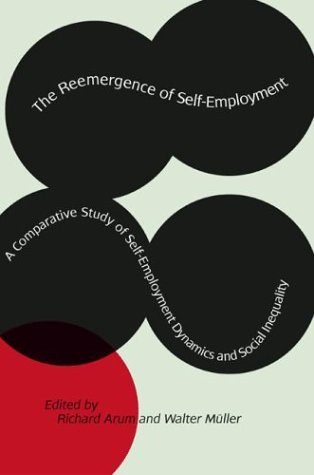The Reemergence of Self-Employment : a Comparative Study of Self-Employment Dynamics and Social Inequality
Arum, Richard and Muller, Walter (Editors)
Princeton University Press, Princeton, NJ
2004
£18.95 (pb)
466 pp.
0691117578
 The Reemergence of Self-Employment is an ambitious work of empirical sociology; it presents the findings of researchers in eleven countries in a single, coherent volume. Editors Richard Arum and Walter Müller have marshalled the efforts of specialists in the field of work and employment (often specifically self employment) from Germany, France, the Netherlands, the UK, the US, Australia, Hungary, Russia, Italy, Japan and Taiwan.
The Reemergence of Self-Employment is an ambitious work of empirical sociology; it presents the findings of researchers in eleven countries in a single, coherent volume. Editors Richard Arum and Walter Müller have marshalled the efforts of specialists in the field of work and employment (often specifically self employment) from Germany, France, the Netherlands, the UK, the US, Australia, Hungary, Russia, Italy, Japan and Taiwan.
The book's title rather gives away one of the main findings of many of the studies therein; that self employment in economically more developed countries is re-emerging. Self employment was previously thought to be undergoing a process of terminal decline since the Second World War; this held particularly for countries such as the UK and the US that were among the first to industrialise and develop as bureaucratic/technocratic states. By this analysis, highly bureaucratised economies, operating under the Fordist model, and dominated in employment terms by large corporations and the state, provided ever fewer economic, social and institutional spaces for self employment. The small shop owner gave way to the giant supermarket chain, the craftsperson to the mass manufacturer. However, the contributors to this volume generally find that although the trend of decline pertained for much of the twentieth century, it has undergone something of a reversal in the last twenty-five years.
The first chapter, by the editors, presents an analytical overview of self employment in the post-war context, and usefully establishes how the rest of the book will approach the topic. Eleven substantive chapters follow, each focusing on a different country. These chapters are structured to reflect the overall aims of the book; since this is a coordinated project, the chapters are designed with a similar format. The distinct historical and institutional setting for self employment in each country is surveyed, and this is followed by a detailed quantitative analysis of trends during the 1980s and 1990s. A key issue addressed is the various factors influencing entry into and exit from self employment, in terms of family background, human capital, and institutional and macroeconomic context. The chapter on the UK, for example, highlights as a reason for resurgent self employment the financial deregulation of the 1980s, with which many readers will be familiar. A series of statistical tables and charts are presented mid chapter, and tend to be followed with a discussion of findings, and then a conclusion.
The theme of social inequality features in the full title of this book, but is not covered to the same extent by every contributor. Indeed, readers looking for a cross-national analysis of social inequality may prefer to look elsewhere. This is not to say that social inequality does not feature, rather that it is generally dealt with in terms of how social inequalities are exacerbated by, or have an effect on, the nature of self employment. A common theme is the effect of gender inequalities on entry into to, and survival of, self-employed status. Some chapters did express the issue of social inequality very clearly; Arum's discussion of the US explains how rising levels of self employment can increase already existing social inequalities between professionals and low paid service workers.
That this volume is ambitious has been noted already, but it does seem to largely fulfil its aim of providing a cross-national survey of recent self-employment dynamics. A strong point of Arum and Müller's book is the way it demonstrates how individual choices are structured by the wider social context; this, it seems, is one of the key aims of the work.
The Reemergence of Self-Employment is highly empirical in approach and relies on complex analysis of large quantitative datasets; it will therefore appeal to sociologists, economists and policymakers who prefer a statistical approach to social analysis. This volume includes 44 illustrations and over 60 statistical tables – and often provides detailed descriptions of how analysis was carried out. One possible weak point was the omission of a detailed look at current theoretical debates on postindustrial society. On a similar point, Barbieri and Bisson (Italy) deal with theories of 'the end of work' and 'the corrosion of character' in a rather cursory manner, without explaining what these phrases really mean.
This collection is generally well written, although Wei-hsin Yu and Kuo-Hsien Su, in their chapter on Taiwan, rather labour the point that self employment is a particularly heterogeneous category.
Global in scope, yet retaining a high level of detail, The Reemergence of Self-Employment is clearly a useful addition to the field of employment research.
Ed Granter
University of Salford.

